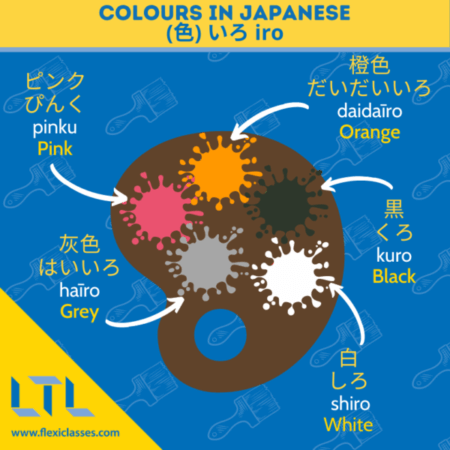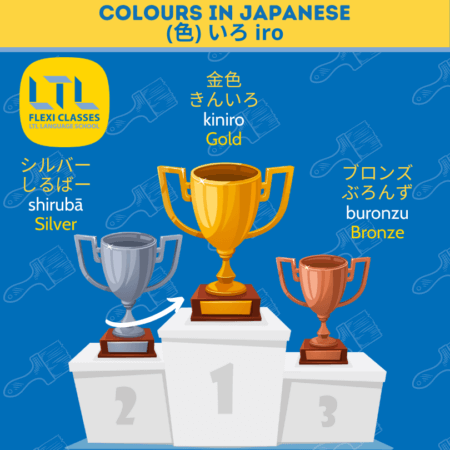Colors in Japanese || A Complete Guide (+ FREE Quiz)
Colors in Japanese || 21 Colors to Learn (with BONUS Content)

Japan is a brilliantly colorful place.
Flashy neon colors light up the sky at night across the country – providing a scene that can blow your mind when first entering Japan!
Far from just this though – its art, design and idyllic nature are awash with color that just demands to be talked about!
Discussing color in Japanese is easy, but there are a few things to bear in mind when you’re learning.
Most important is that the specific word used for a color can change depending on their part of speech, i.e., if the color is used like a noun or an adjective.
Confused? Don’t worry – it’s much easier than it sounds.
Colors in Japanese || A Quick Intro
Colors in Japanese || 10 Most Common
Colors in Japanese || Describing with Color
Colors in Japanese || Adding い
Colors in Japanese || More Colors
BONUS || Free Quiz
Colors in Japanese || FAQs
Japanese Colors || A Quick Intro
A couple of points from the start
DID YOU KNOW || It is also common for colors to have both a “Japanese” term, i.e., 赤 aka for Red, and loan word version, i.e., レッド reddo for, you guessed it, red!

Secondly, colors in Japanese often end in the word 色 (いろ iro), which means “color.”
色 iro can also be used on its own, for example in the question, “what is your favorite color?” This can be asked in two different ways:
何色が一番好きですか。/ 大好きな色は何ですか。
naniiro ga ichiban sukidesuka. / daisukina iro wa nandesuka.What is your favorite color?
With those important points out of the way, let’s get on and learn the most used colors in Japanese

Japanese Loanwords 🤩 41 You Should Learn Straight Away
Japanese Loanwords are actually a great way to boost language learning motivation because it makes you realise you can still find similarities with English!
Japanese Colors || 10 Most Common
Let’s look at a list of some of the 10 most common colors in Japanese.
NOTE || The following colors are all nouns.
| English | Japanese | Furigana | Romaji |
|---|---|---|---|
| Red | 赤 | あか | aka |
| Blue | 青 | あお | ao |
| Yellow | 黄色 | きいろ | kiiro |
| Green | 緑 | みどり | midori |
| Orange |
オレンジ
/ 橙色 | おれんじ / だいだいいろ | orenji/ daidaiiro |
| Purple | 紫 | むらさき | murasaki |
| Black | 黒 | くろ | kuro |
| White | 白 | しろ | shiro |
| Pink | ピンク | ぴんく | pinku |
| Brown | 茶色 | ちゃいろ | chairo |
You’ll notice that for “orange” and “pink,” a loan word is used, unlike the other colors which use a Japanese-derived word.
There is a more traditional Japanese term for pink, which is 桃色 momoiro, literally meaning “peach color.” However, this term is less common in modern Japanese.
Japanese Colors || Describing with Color
The above colors in Japanese are listed as nouns.
When we are describing something, we should put the color word first, followed by の no, and then the object we are describing.
So that’s color + の + object (n.)
FOR EXAMPLE ||
- 紫の花 murasaki no hana – purple flowers
- 黄色の鳥 kiiro no tori – yellow bird
- ピンクの靴 pinku no kutsu – pink shoes
How about a couple of example sentences using Japanese colors?
紫の花が咲いています。murasaki no hana ga saite imasu.
The purple flowers are in bloom.
彼女はピンクの靴を履いています。kanojo wa pinku no kutsu wo haite imasu.
She is wearing pink shoes.
NOW IT’S YOUR TURN || Can you write a sentence in Japanese using color? Comment below and we’ll reply 😎
Japanese Colors || Adding い
For a select number of colors in Japanese, we can use them as adjectives by adding い, thus turning them into い-adjectives.
We cannot do this with every color so pay attention to which ones work!
| English | Japanese | Furigana | Romaji |
|---|---|---|---|
| Red | 赤い | あかい | akai |
| Blue | 青い | あおい | aoi |
| Black | 黒い | くろい | kuroi |
| White | 白い | しろい | shiroi |
| Yellow | 黄色い | きいろい | kiiroi |
| Brown | 茶色い | ちゃいろい | chairoi |
IMPORTANT || Remember い-adjectives can be put directly in front of a noun.
い-adjective + object (n.)
ADDITIONAL RESOURCES || Need a refresher on using い-adjectives? Check out LTL’s Japanese grammar bank for some useful tips.
For example:
- 赤いバス akai basu – red bus
- 青い海 aoi umi – blue sea
- 黒い車 kuroi kuruma – black car
- 白い雲 shiroi kumo – white clouds
FOR EXAMPLE ||
ロンドンで赤いバスが多いです。Rondon de akai basu ga ooidesu.
There are many red buses in London.
窓から青い海が見られます。mado kara aoi umi ga miraremasu.
You can see the blue sea from the window.

Verbs in Japanese // A Beginners Guide
Learning Verbs in Japanese isn’t all that hard. We teach you the basics with this super easy to follow guide which also includes a quiz at the end.
Japanese Colors || More Colors

Of course, there are many more colors than the ones listed above…!
Often, colors in Japanese will be named after objects that are that color.
We’ve already seen that in the word for “brown” 茶色 which literally translates to “tea color.”
Here are a few other examples:
- 水色 mizuiro – light blue (literally “water color”)
- 金色 kiniro – gold
- 銀色 giniro – silver
- 桜色 sakurairo – light pink (literally “sakura/cherry blossom color”)
- 梅紫 umemurasaki – plum
- 墨色 sumiiro – ink black (literally “ink color”)
Let’s add a few more colors and summarise them all in this table.
| English | Japanese | Furigana | Romaji |
|---|---|---|---|
| Black | 黒 | くろ | kuro |
| Blue | 青 | あお | ao |
| Brown | 茶色 | ちゃいろ | chairo |
| Cerise | セリーズ | せりーず | serīzu |
| Green | 緑 | みどり | midori |
| Grey | 灰色 | はいいろ | haīro |
| Gold | 金色 | きんいろ | kiniro |
| Indigo | インディゴ | いんでぃご | indego |
| Ink Black | 墨色 | すみいろ | sumiiro |
| Light Blue | 水色 | みずいろ | mizuiro |
| Light Pink | 桜色 | さくらいろ | sakurairo |
| Lilac | ライラック | らいらっく | rairakku |
| Orange |
オレンジ
/ 橙色 | おれんじ / だいだいいろ | orenji/ daidaiiro |
| Pink | ピンク | ぴんく | pinku |
| Plum | 梅紫 | うめむらさき | umemurasaki |
| Purple | 紫 | むらさき | murasaki |
| Red | 赤 | あか | aka |
| Silver | 銀色 | ぎんいろ | giniro |
| Turquoise | ターコイズブルー | たーこいずぶるー | tākoizuburū |
| White | 白 | しろ | shiro |
| Yellow | 黄色 | きいろ | kiiro |

DID YOU NOTICE || The Japanese colors that use Katakana. These are the easiest to remember as they sound almost the same as the English equivalent.
Now can you tell us your favourite color in Japanese using a full sentence?
Or do you have any questions about using color in Japanese?
Leave us a comment below and we’ll get back to you!

Some Easily Confused Hiragana and Katakana || Read Japanese Like a Pro
Learning Japanese can be tricky, especially with the confusing and similar looking letters. Today, we help you banish these fears as we show you how it’s done.

How To Learn Katakana (カタカナ) // Essential Things To Know
How to Learn Katakana? | Katakana is one of Japanese’s three alphabets. Katakana are generally more angular looking than Hiragana and focuses on loanwords.
Want to learn all the colors of the rainbow (and more) in other languages too?
- Learn 20+ colors in Mandarin Chinese (with free quiz)
- Discover the colors in Vietnamese
- Find out how to say all the colors in Korean
- Unlock Colors in Spanish
What are you waiting for 🙂
Japanese Colors || BONUS Quiz
Let’s see how many of those colors in Japanese you remembered.
Here is a quick fire 10 question quiz to see how well do you! Drop us a comment below with your final score 😎
Japanese Colors || FAQs
How do you say color in Japanese?
Color in Japanese is 色 (いろ iro).
This is often added to the end of a word to turn it into a color.
FOR EXAMPLE || 黄色 simply means yellow (or yellow color).
What is red in Japanese?
Red in Japanese is 赤 (aka).
What is blue in Japanese?
Blue in Japanese is 青 (ao).
What is white in Japanese?
White in Japanese is 白, which is pronounced as shiro.
What are some example sentences that use colors in Japanese?
窓から青い海が見られます means “I can see the blue sky from the window”.
mado kara aoi umi ga miraremasu.
—
ロンドンで赤いバスが多いです。means “There are many red buses in London”.
Rondon de akai basu ga ooidesu
—
紫紫の花が咲いています。means “There are many purple flowers in bloom.”
murasaki no hana ga saite imasu.
Want More From LTL?
WANT TO LEARN JAPANESE? Check out our online Japanese courses here.
We offer a 7-day free trial to all new students where you can study 24/7.
What about studying Japanese in Japan instead? We’ve got your back. Our Japanese courses in Tokyo can either be taken in small groups of no more than 5 students or individually for a more tailored experience.
We even offer incredible homestay experiences in Tokyo as well.
Come and be a part of this amazing community.










